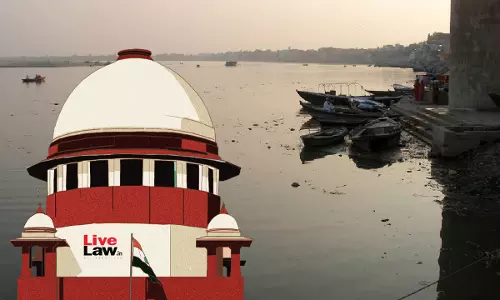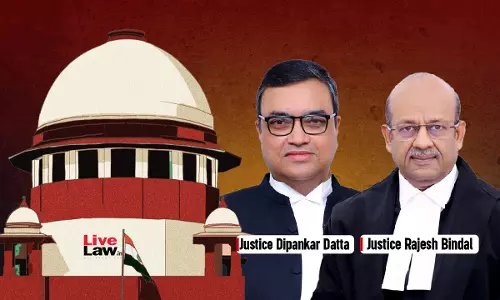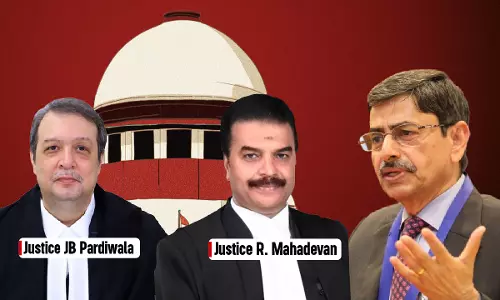'Are They Destined To Carry Their Backwardness Till Eternity?': SC Says Fruits Of Reservation Not Reaching Lowest Strata Of SC-STs [Read Judgment]
"The million dollar question is how to trickle down the benefit to the bottom rung; reports indicate that benefit is being usurped by those castes (class) who have come up and adequately represented.";
![Are They Destined To Carry Their Backwardness Till Eternity?: SC Says Fruits Of Reservation Not Reaching Lowest Strata Of SC-STs [Read Judgment] Are They Destined To Carry Their Backwardness Till Eternity?: SC Says Fruits Of Reservation Not Reaching Lowest Strata Of SC-STs [Read Judgment]](https://www.livelaw.in/h-upload/2020/08/27/1500x900_380538-370150-5-judge-bench-justice-arun-mishra-1.jpg)
The Constitution Bench of the Supreme Court opined that the State Government can give the preferential treatment to a particular class more backward out of Scheduled Castes and Scheduled Tribe without depriving others of benefit. The bench, has made several observations in the judgment in favour of revisiting the dictum in E V Chinnaiah vs State of Andhra Pradesh, though it referred the...
The Constitution Bench of the Supreme Court opined that the State Government can give the preferential treatment to a particular class more backward out of Scheduled Castes and Scheduled Tribe without depriving others of benefit.
The bench, has made several observations in the judgment in favour of revisiting the dictum in E V Chinnaiah vs State of Andhra Pradesh, though it referred the matter to larger bench since EV Chinnaiah is a judgment of a five judge bench.
Justice Arun Mishra, who authored the judgment for the bench, observed that there are unequals within the list of Scheduled Castes, Scheduled Tribes, and socially and educationally backward classes and that the fruits of reservation is not reaching the lowest strata. It observed that the State cannot be deprived of the power to take care of the qualitative and quantitative difference between different classes to take ameliorative measures. Concluding its 78 page judgment, the court observed thus:
"The interpretation of Articles 14, 15, 16, 338, 341, 342, and 342A is a matter of immense public importance, and correct interpretation of binding precedents in Indra Sawhney and other decisions. Though we have full respect for the principle of stare decisis, at the same time, the Court cannot be a silent spectator and shut eyes to stark realities. The constitutional goal of social transformation cannot be achieved without taking into account changing social realities."
Click here to read the background of the case
Does Preferential Treatment Include and Excludes Castes?
One of the questions considered by the bench, also comprising Justices Indira Banerjee, MR Shah, Vineet Saran and Aniruddha Bose, was whether subclassification made or preferential treatment within the class of Scheduled Castes, Scheduled Tribes and socially and educationally backward classes can be said to be an exercise of inclusion or exclusion particularly when the other castes in the list of Scheduled Caste persons are not deprived of the benefit of reservation in totality? It observed:
All the castes included in the list of Scheduled Caste are given the benefit of reservation as per representation in service, but only specific percentage fixed for preferential treatment to a caste/class which was not able to enjoy the benefit of reservation on account of their being more backward within the backward classes of Scheduled Castes. The preferential treatment would not tantamount to excluding other classes as total deprivation caused to any of the castes in the list of Scheduled Caste under Article 341(2). Caste is nothing but a class. It is the case of classification to provide benefit to all and to those deprived of the benefit of reservation, being the poorest of the poor. Whether the action based on intelligible differentia to trickle down the benefit can be said to be violative of Articles 14 and 16 of the Constitution and whether subclassification can be said to be an act of inclusion or exclusion particularly when various reports indicating that there is inequality inter se various castes included within the list of Scheduled Castes. They do not constitute homogenous class have been relied upon. Based on the report and to give adequate representation to those who continue to remain the most backward of the downtrodden class, the provisions containing a certain percentage of preferential treatment subject to availability without depriving others in the list were made.
The bench noted that, in Indra Sawhney, it was held that it is permissible to make sub classification within socially and educationally backward classes. That discussion would be applicable for Scheduled Castes and Scheduled Tribes as they admittedly fall under Article 16, it added.
How to trickle down the benefit to the bottom rung?
Another question which was considered was whether subclassification for providing benefit to all castes can be said to be tinkering with the list under Articles 341, 342 and 342A, in view of the decisions in Indra Sawhney, permitting subclassifications of backward classes and in Jarnail Singh, in which, it was opined that 'creamy layer concept' for exclusion of benefit can be applied to the Scheduled Castes and Scheduled Tribes and it does not in any manner tinker with the Presidential list under Article 341 or 342 of the Constitution. The Court opined:
"The caste or group or subgroup continued exactly as before in the list. It is only those persons within that group or subgroup, who have come out of untouchability or backwardness by virtue of belonging to the creamy layer, who are excluded from the benefit of reservation. The million dollar question is how to trickle down the benefit to the bottom rung; reports indicate that benefit is being usurped by those castes (class) who have come up and adequately represented. It is clear that caste, occupation, and poverty are interwoven. The State cannot be deprived of the power to take care of the qualitative and quantitative difference between different classes to take ameliorative measures.
The entire basket of fruits cannot be given to mighty at the cost of others under the guise of forming a homogenous class.
The court observed that subclassification was made under Section 4(5) of the Punjab Act to ensure that the benefit of the reservation percolate down to the deprived section and do not remain on paper and to provide benefit to all and give them equal treatment. On the question whether it is violative of Article 14, the bench observed:
In our opinion, it would be permissible on rationale basis to make such subclassification to provide benefit to all to bring equality, and it would not amount to exclusion from the list as no class (caste) is deprived of reservation in totality. In case benefit which is meant for the emancipation of all the castes, included in the list of Scheduled Castes, is permitted to be usurped by few castes those who are adequately represented, have advanced and belonged to the creamy layer, then it would tantamount to creating inequality whereas in case of hunger every person is required to be fed and provided bread. The entire basket of fruits cannot be given to mighty at the cost of others under the guise of forming a homogenous class.
Notably, the same bench had made similar observations in the case Chebrolu Leela Prasad Rao and others vs State of Andhra Pradesh and others also.
Affluent & Advanced Within SC/ST Not Permitting Reservation Benefits Trickle Down To Needy : SC Calls For List Revision [Read Judgment]
The question of immense public importance arises in view of the insertion of Article 342A
The Court also noted the impact of Article 342A inserted by the Constitution (One Hundred and Second Amendment) Act, 2018, w.e.f. 14.8.2018.
The provisions of Articles 341, 342, and 342A are pari materia, and the reservation for socially and educationally backward classes was the subject matter under consideration in Indra Sawhney. Thus, the question arises how different opinions can be expressed with respect to Scheduled Castes, Scheduled Tribes, and socially and educationally backward classes for the purposes of the classification. The provisions of Article 16(4) and Article 342A indicate that it would not be permissible to adopt different criteria for Scheduled Castes, Scheduled Tribes, and socially and educationally backward classes. The authoritative pronouncement is required with respect to the effect of aforesaid provisions of the Constitution and whether subclassification is permissible only with respect to the socially and educationally backward classes covered under Article 342A read with Article 366(26C) and not with respect to Scheduled Castes and Scheduled Tribes covered under similar provisions, i.e., under Articles 341 and 342 read with Article 366(24) and 366(25) respectively. The question of immense public importance arises in view of the insertion of Article 342A. When we consider Indra Sawhney, permitting such classification of socially and educationally backward class, and provisions of Articles 341, 342, and 342A are pari materia, the Court is required to have a fresh look on the decision rendered in E.V. Chinnaiah. In the spirit of constitutional provisions, the question is required to be reexamined authoritatively by this Court being of immense public importance. Thus, the case is required to be heard by a larger Bench than the one which decided E.V. Chinnaiah
Following are some other observations made by the bench:
Disparity within Scheduled Caste is writ large
There is cry, and caste struggle within the reserved class as benefit of reservation in services and education is being enjoyed, who are doing better hereditary occupation. The scavenger class given the name of Balmikis remains more or less where it was, and so on, disparity within Scheduled Caste is writ large from various reports.
The aspiration of equal treatment of the lowest strata, to whom the fruits of the reservation have not effectively reached, remains a dream
The Constitution is an effective tool of social transformation; removal of inequalities intends to wipe off tears from every eye. The social realities cannot be ignored and overlooked while the Constitution aims at the comprehensive removal of the disparities. The very purpose of providing reservation is to take care of disparities. The Constitution takes care of inequalities. There are unequals within the list of Scheduled Castes, Scheduled Tribes, and socially and educationally backward classes. Various reports indicate that Scheduled Castes and Scheduled Tribes do not constitute a homogenous group. The aspiration of equal treatment of the lowest strata, to whom the fruits of the reservation have not effectively reached, remains a dream. At the same time, various castes by and large remain where they were, and they remain unequals, are they destined to carry their backwardness till eternity?
It is for the State Government to judge the equitable manner in which reservation has to be distributed
The State's obligation is to undertake the emancipation of the deprived section of the community and eradicate inequalities. When the reservation creates inequalities within the reserved castes itself, it is required to be taken care of by the State making subclassification and adopting a distributive justice method so that State largesse does not concentrate in few hands and equal justice to all is provided. It involves redistribution and reallocation of resources and opportunities and equitable access to all public and social goods to fulfil the very purpose of the constitutional mandate of equal justice to allProviding a percentage of the reservation within permissible limit is within the powers of the State legislatures. It cannot be deprived of its concomitant power to make reasonable classification within the particular classes of Scheduled Castes, Scheduled Tribes, and socially and educationally backward classes without depriving others in the list. To achieve the real purpose of reservation, within constitutional dynamics, needy can always be given benefit; otherwise, it would mean that inequality being perpetuated within the class if preferential classification is not made ensuring benefit to all.The subclassification is to achieve the very purpose, as envisaged in the original classification itself and based thereupon evolved the very concept of reservation. Whether the subclassification would be a further extension of the principle of said dynamics is the question to be considered authoritatively by the Court.The State Government is conferred with the power to provide reservation and to distribute it equitably. The State Government is the best judge as to the disparities in different areas. In our opinion, it is for the State Government to judge the equitable manner in which reservation has to be distributed. It can work out its methodology and give the preferential treatment to a particular class more backward out of Scheduled Castes without depriving others of benefit.
In the federal structure, the State, as well as the Parliament, have a constitutional directive for the upliftment of Scheduled Castes, Scheduled Tribes, and socially and backward classes. Only inclusion or exclusion in the Presidential notification is by the Parliament. The State Government has the right to provide reservation in the fields of employment and education. There is no constitutional bar to take further affirmative action as taken by the State Government in the cases to achieve the goal. By allotting a specific percentage out of reserved seats and to provide preferential treatment to a particular class, cannot be said to be violative of the list under Articles 341, 342, and 342A as no enlisted caste is denied the benefit of reservation
Case Details :
Title : The State of Punjab and others vs Davinder Singh and others
Coram : Justices Arun Mishra, Indira Banerjee, Vineet Saran, MR Shaha and Aniruddha Bose.




